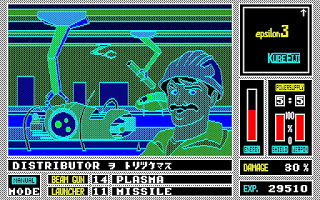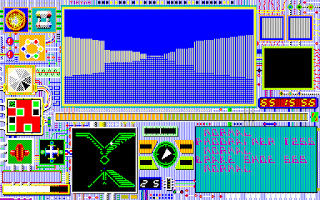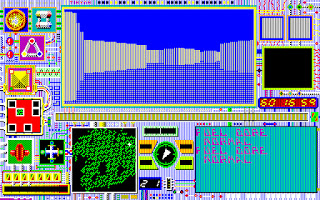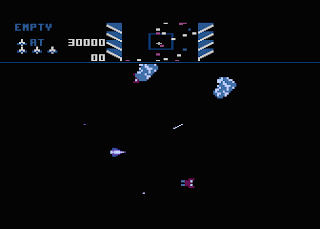Name:Dimensional Fighter Epsilon3
Number:94
Year:1985
Publisher:Bullet-Proof Software
Developer:Bullet-Proof Software
Genre:FPS/RPG
Difficulty:5/5
Time:10 hours 00 minutes
Dimensional Fighter Epsilon3 is the first FPS/RPG hybrid, at least according to what little there is on the game around. Take Wizardry, strip out most of the RPG part, then take a light gun game, add in limited ammo, have battles be the light gun game and the Wizardry-lite be the RPG part. As a result its sort of questionable to call this the first FPS/RPG. Its not really a FPS, and its hard to call it a RPG, since I barely felt like I was gaining any sort of stats.
Published by Bullet-Proof Software, previously mentioned on this blog for Faceball 2000. The man who founded BPS is truly a man of the world. Henk Rogers, born in the Netherlands to Dutch and Indonesian parents, before they moved to New York. He studied computer science at the University of Hawaii before founding BPS in Japan. He's also attached to the American releases of Tetris, becoming friends with Alexey Pajitnov. Unfortunately, I don't know much about the actual developer of this game, one Eiji Kure, except that he likes making RPGs.
 |
Can you spot the enemy here?
|
This is the first PC-88 game I've really played, so there's a bit of confusing stuff going on. Firstly, none of the emulators I tried have a great screenshot function, nothing bindable, just ALT+F2 or whatever they pick, assuming its useable at all. Secondly, the game had V1 after its file, which I ignored for the first couple of sessions. This was a mistake on my part, because it wants me to play in V1 mode, as the system had modes like that. I don't understand it, but I don't have to. Playing the game in V2 will cause the game to look like an unholy abomination against god and man, and this isn't an appealing-looking game to begin with. There were ghosts of walls.
 |
There's this cool cutscene where the camera slowly moves up the mech and its much nicer than what they drew deserves
|
The story is the player is controlling the last hope against a superior enemy that wants to eradicate all life. To stop them, the player has to free 3 cities. Starting it up, there are two modes, a play mode and a demo mode. Demo is a demo, but doesn't really show much. The game has a slightly confusing start-up procedure. You need the game disk in one floppy drive and the user disk in the other, otherwise you'll get stuck in an endless loop. From there you pick a city and start playing. That implies you have a choice, but playing anything other than the first city will result in your swift death. This is easy to screw up even when you have some idea of what you're doing. Saving is accomplished by going back to the building you started at and going forward with Numpad 5.
 |
A typical gameplay scene, I'm almost dead, but otherwise in good shape
|
Visually, it looks like Wizardry, except outside, and kind of weird. You can see about three squares away. Movement is done with the numpad arrows, along with numpad 5 to enter buildings. This is necessary because many, many things are inside these buildings. There are also things you pick up on the ground. You can access a menu with M or change the scenery and enemy colors with F. Its still the kind of game that I feel the need to take frequent breaks from.
 |
A typical battle, I'm not losing yet, but it will happen
|
It doesn't take long for the meat of the game to happen, combat. This is done like a light gun game, move your crosshair, and then try to hit an enemy's weakspot. As seems to be usual with this sort of game, whether or not you can actually win these fights seems to be as much down to luck as it is skill. Well, more skill than luck than it seems usually. Some enemies seem like they're constantly running back and forth, but they're really just moving because you have your crosshair over them. That's not to say its good, just that it gets...tolerable, I guess.
 |
The screen changes colors as you take damage, this isn't the worst it could be
|
This runs into the same problems that Death Duel had, the only way to make such a game difficult is to require precision. To achieve precision in a game where I aim a crosshair with my keyboard is something that isn't going to happen. Further, there are nasty things going on, there are mine enemies that move in and out of the ground, you can't hit them while they're in the ground. Some enemies in city 2 I could miss even if my crosshair was on the target. Missiles sometimes took so much time to reach a target I was already at zero shield by the time it hit them, thus negating the point of firing it.
 |
Mines, possibly the most annoying enemy in the game
|
As the enemies increase in difficulty it doesn't feel like you get any way of countering it. Heavier weapons are not commonly given out, and lighter weapons don't seem to do any damage. Since there's no indication of whether or not you're hitting the weak spot or just firing at the body pointlessly, you can waste those heavier weapons, and probably die.
 |
A tiny bunker, after it has been destroyed, note my drained supplies
|
But there are elements that I like, enemies usually don't fire when they're standing still, I.E., the point I'm most likely to hit them. Enemies usually go down pretty quickly. Battles have two lengths, short and painfully long, and when its the first one, it isn't that bad. When I miss my opening salvo battles become death marches, and if I don't win they come straight back.
 |
Some buildings have these graphics and you get stuff. For some reason, this one looks like a stereotypical Italian
|
Your weapons, which you change with the A & S keys and fire with the Z & X keys, take time to hit your target. There is a limited supply but with beam weapons you can get a recharge back at base. Your missiles, on the other hand, don't replenish. You have to hope some monster you fight drops them. That's not to say there aren't some beam weapons you can only get from enemies, but its obvious you're going to hold tight on those. Energy is also in limited supply, and powers shields, weapons and movement. Fortunately, enemies drop energy, and you can sometimes find it on the ground.
 |
An unceremonious game over screen
|
This game has a major flaw with it, in that the game is designed in such a way that it takes the worst elements of both genres. RPGs around this time required you to map them otherwise you would never finish them. This is not a problem if the game is designed so you have distinct landmarks you can use to orient yourself. DFE3 does not, you start in a small circle of buildings and then an empty wilderness. There is one unusual building on the north end. You have to fight constantly to get navigation tools, like a compass, which has reversed east and west directions for some reason.
 |
A good half of the gameplay the first hour
|
The map itself is deceptively big. You have a large area surrounding the start, and then random scatterings of buildings. The meat of the "city" is a city connected to a giant bunker. The map loops around itself, so exploring at first might make you think there are two cities, but really, there's only one. This is quite different from the usual RPG experience where every square might matter. At least that's what's important outside of the city, inside you have to check every building, every square, possibly even every wall. There are many important items hidden in buildings, not like weapons or energy, but items that grant you new abilities.
 |
You have to destroy each one, and yes, you have to hit a precise target on them that isn't fully explained
|
This isn't the only thing inside buildings, in addition, there are pairs of turrets you sometimes encounter and dark rooms where enemies sometimes appear. The reward far outweighs the risk, even though at first you need an item to see those enemies. The issue is that once you go over the area once or twice there's not really any obvious next step. The pairs of turrets respawn after a time, so clearly that's not the way forward. There's a big bunker on the north side of the city or south of the starting area, but it only has a map function. Which isn't all that helpful. Going to the next city (as in map) cranks up the difficulty of enemies to a degree higher than I was capable of reasonably dealing with.
 |
I didn't notice the old-style mainframes there. I guess its got more to do with '70s sci-fi than '80s sci-fi
|
Which resulted in me quitting. It wasn't the difficulty, the controls or the shoddy in-game navigation tools. The lack of an immediate objective. It felt like I had done all there was to do in the first city, and yet the second was still difficult fight, some fights were effectively game over. Every building wall could contain an entrance, even if the others do not, which is just too much work for too little reward. Having to hunt down every wall for secrets isn't something I enjoy in actual FPS titles, let alone this game. I've seen enough to know I'm not going to like what I see at the end.
Weapons:
While there were a few special weapons that changed things up, the weapons are basically interchangeable and all take time to hit a target. They feel weighty, but I never feel like I'm hitting anything. 2/10
Enemies:
There are four types of regular enemy, and three stationary kinds, these get upgraded after each city. Some are more annoying than others, but they all have interesting behavior going on. 3/10
Non-Enemies:
None.
Levels:
While RPGs have different standards than FPS games, and this falls more into the former category, I don't think this is all that good there either. Far too many areas require you to count how many steps you took in order to get an accurate picture, which is a problem considering how high the encounter rate is. With, of course, all that wall-humping. 3/10
Player Agency:
Outside of the combat controls its pretty good. The special items are clearly marked once you figure out that M is menu. They all work very well. That combat though, its never going to get any better. 2/10
Interactivity:
None.
Atmosphere:
There is something there. There's something interesting about the way the game is set up, with its black skies and outdoor Wizardry-style gameplay. Its certainly unique among its kind. 2/10
Graphics:
I feel like this game is a weird monkey paw. I like seeing attempts at B&W games and this applies the same principals you would see in one of those titles. Most everything is one color and black. The enemy graphics are nice, but there's not a lot of animation. The full-screen shots are awkward-looking. 2/10
Story:
Generic save the people story, doesn't really come up in-game.
Sound/Music:
A few blips and bloops. 1/10
That's 15 in total. Which is about average in what I give games, but not a good rating.
I can't really recommend it as a RPG, or a FPS, but there is something about this game that's fun and interesting. I think I would like to see a remake of this game, one with mouse aiming and a reduced encounter rate.
Curiously, I'd attribute one thing to this game that isn't mentioned anywhere, secrets. Since none of the doors are visible until you actually go in, they're all secret. I mean, its not good, you have to find secrets in order to win, but it exists, which is the important bit.
In theory, this marks the end of the first half of the '80s for FPS titles. There are a ton of Japanese titles on personal computers that we don't know anything about, and the only way of finding out is to actually fire them up. This is the flaw in me playing FPS titles on a separate list than the rest of them, I don't have time to properly go through everything. Currently, I'm exploring the PC-6001, which has an interesting library. There are many strange games and programs on the system, some of the less interesting ones may make an appearance here.




































